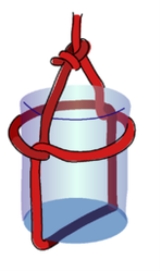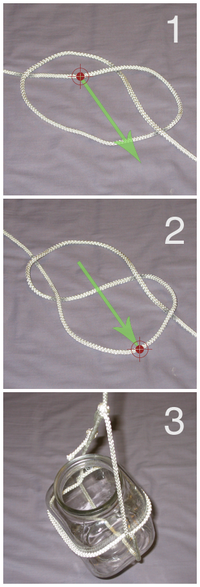
Barrel hitch
Encyclopedia
The "barrel hitch" and "barrel sling
," named for their use in hoisting cargo aboard ships, are a simple yet effective way to suspend an object. The barrel sling lays the barrel on its side, while the barrel hitch keeps it vertical. They work by forming a "sling" around the object, which supports it from either side and underneath.
The barrel sling (not pictured) is made with a strop. The barrel is laid on its side, both sides of the strop are spread out and passed underneath, the ends of the strop are raised together, one end is tucked through the other and hooked to an eyehook. The tightened knot looks like a cow hitch. A cow hitch and bowline can achieve the same effect and are called a "cow hitch hoist." The barrel hitch for lifting bales of hay is called a "bale sling hitch."

Bale sling hitch
The bale sling hitch is a knot which traditionally uses a continuous loop of strap to form a cow hitch around an object in order to hoist or lower it. In practice, a similar arrangement can also be formed using a fixed loop at the end of a rope. This loop could be formed at the end of a line...
," named for their use in hoisting cargo aboard ships, are a simple yet effective way to suspend an object. The barrel sling lays the barrel on its side, while the barrel hitch keeps it vertical. They work by forming a "sling" around the object, which supports it from either side and underneath.
The barrel sling (not pictured) is made with a strop. The barrel is laid on its side, both sides of the strop are spread out and passed underneath, the ends of the strop are raised together, one end is tucked through the other and hooked to an eyehook. The tightened knot looks like a cow hitch. A cow hitch and bowline can achieve the same effect and are called a "cow hitch hoist." The barrel hitch for lifting bales of hay is called a "bale sling hitch."
Tying

- The barrel hitch is made by tying an overhand knotOverhand knotThe overhand knot is one of the most fundamental knots and forms the basis of many others including the simple noose, overhand loop, angler's loop, reef knot, fisherman's knot and water knot. The overhand knot is very secure, to the point of jamming badly. It should be used if the knot is...
, leaving plenty of free rope at the working end. Where the rope crosses itself in the middle of the knot (near the target), grab the strand of rope on top and bring it towards you, then lay it back down. The result should resemble stage 2: note where the target is. - Place your object on top of the diagonal strand of rope in the centre of the knot.
- Carefully draw the rope up at the working and fixed ends, forming the "sling" around the object. Tie the working end off using a bowlineBowlineThe bowline is an ancient and simple knot used to form a fixed loop at the end of a rope. It has the virtues of being both easy to tie and untie. The bowline is sometimes referred as King of the knots because of its importance...
, making sure the sling is tight around the object.

